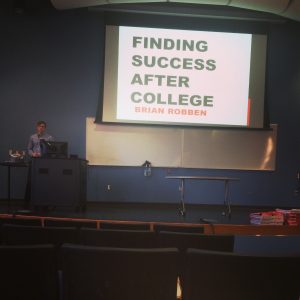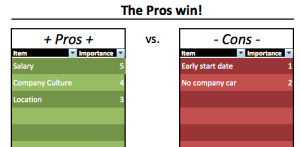 (To view my thoughts before the presentation, click here for Part I.)
(To view my thoughts before the presentation, click here for Part I.)
Monday night, I spoke in front of Alpha Chi Omega and Phi Mu for about thirty minutes on the subject of finding career success after college: how to prepare for it. Since this was the first time I spoke publicly about Take Your Success, I did thorough research of my topic and how to effectively present.
Below, I share the main points of my talk and then some key presentation tips that I discovered to increase audience engagement.
Summary Of My Speech
Troubling statistic
According to a 2014 report by the Conference Board, a New York-based nonprofit group, 52.3% of Americans are unhappy at work. This trend of unhappy working Americans has grown over the years, and one can assume that this percentage is higher in 2015. This is a big deal in itself, and diving into where the hours go each week makes the statistic appear even worse.
There are 168 total hours each week. Once you subtract around 56 hours sleeping and 35 hours showering, eating, and traveling, you’re left with 77 hours. Most full-time jobs are 40 hours, so there is 37 free-time hours left in your week. This means that if you’re unhappy at work, you’re spending more time unhappy (40 hours a week) than you are enjoying yourself (37 hours a week). Plus, once you grow older and take on more responsibilities—spouse, kids, more work, etc.—your amount of free time decreases. As you age, you could potentially only have 10 peaceful hours a week to yourself.
What’s the point?
The point is that you’re likely to spend most of your future at work, and if you want to be happy, then it’s important that you find the right jobs and career for you.
How do you find the right jobs and career for you?
Well, you need to determine what you really want. By this, I mean finding your long-term goal that is going to take decades to accomplish. Otherwise, if you don’t start with what you want and the end in mind, then you could be blindly hoping you don’t join the 52.3% of workers who are unhappy at work. I assume that these people didn’t reflect on what they wanted, had no plan going into work, or fell into the trap of doing what other people told them would be a good fit.
How do you decide what you want?
This is where knowing yourself is really important. If you have answers for what you like and dislike, what you’re good at and not so good at, and what you are passionate about enough to do for decades, then you’ll be on the right path to find the career that is best for you.
A specific way to help yourself find answers is to speak with people who are currently in a position that you are considering. Bluntly ask them (in person, email, phone call) if they enjoy their job or not, and why. From my experience, they will almost always tell you because they have nothing to lose or gain. Ask about the kinds of people they deal with in their work, too.
Also, interning is another great way to determine what you will enjoy and not enjoy. While you’re an intern, think about if you could do the work, be in that environment, and be around those types of people for years.
And, follow the people who work in the field you might want to pursue on social media (if possible). We are lucky to live in this age where we can get access to the lives of professionals through Facebook, Twitter, and Instagram. So, see what they do each day, and think if it interests you.
The quicker you can find what you want, the earlier you can get started on achieving it. Yet, it’s more important to get this right, then do it fast and get it wrong.
Why finding what you want helps
Finding what you really want first gives you a roadmap and internal compass to your long-term goal. This is beneficial because it allows you to take risks and chances knowing that if you go off course for a little, you can redirect back to another option that helps you get closer to your main goal. The people who don’t have a long-term plan of what they really want, could lose five years in the wrong job if they’re taking things day-by-day.
Also, they won’t be taking positive actions to reach the right thing, because they don’t know what they want. It’s similar to shooting a basketball. If you don’t know where the basket is, it’s one million times harder to make the shot.
Secondly, having a mental picture of what you want will give the struggles and hardship a greater purpose. No matter what you decide to do, there will be things that suck that you have to go through. Yet, your long-term goal helps because you know these trials are necessary to get what you want. Again, the person without a long-term plan will be unhappy in difficult times if they don’t see the point in them. Another negative aspect in not seeing the value in an activity is greater procrastination.
Lastly, if you’re certain in what you really want, you’re more likely to reach your potential; because you’re going to take big, positive actions to get to your end-goal, and then these big, positive actions will produce big, positive results. And, these results will further solidify your belief system for more success in the future. Tony Robbins explains this in his video on the The Success Cycle.
General tips
Don’t pick a job or career only because of the money. I don’t think money is evil. I actually think money is very important. But, if you’re stuck in a job that you hate and are miserable, you will be so drained and down emotionally that the money won’t be worth it.
You will also be better off by focusing on one field or industry that you can master. There isn’t enough time in the world to excel in two different industries at once.
So, if you know what you want, remain positive, and stay focused for the long haul, then you will be more likely to accomplish your dream and have a fulfilling, successful, and happy career.
Action Steps
1. Find what you really want to do in your long-term career.
2. Think of and take an action step in the next week to get closer to this long-term goal.
Presentation Tips
Through speaking, I also learned some presentation tips that you can use when talking in front of your class, student organization, or whatever the situation is. Just so you know, these presentation tips don’t cover everything. Instead, their purpose is to help you understand the major essentials.
1. Put the least amount of words possible on each slide, while still getting the main idea down.
A rough guideline is five to eight words per slide. Also, having limited words on the screen holds you accountable to being prepared, because you can’t use the crutch of just saying the text on the slide.
2. Do enough research and reflection that you can easily expand on the main ideas in the PowerPoint.
Since people can see the main idea on each slide, the way you make your presentation a step above the rest is your examples, stories, and analysis of the main points. Make sure to research and have one of these elements for each slide. An easy way to take pressure off of remembering everything is to make notecards with talking points (beyond the text on the screen). Don’t memorize anything, or else you’ll probably be boring and unnatural.
3. Because the audience members can only hold their attention for so long, give them something different to do after each fifteen minute segment.
Examples include asking a question that they have to tell the person next to them, or showing a short video that compliments your presentation. The audience will be re-energized and re-focused on your presentation thanks to these breaks.
4. Practice your presentation multiple times—to be safe and confident.
Because the slides aren’t that helpful for you with only five to eight words and we want to avoid memorization, practicing your presentation at least three times is crucial. The more you prepare before the talk, the better you’ll feel and execute. Think back to a time when you were in the audience: Isn’t there a big difference between a confident speaker and a nervous one?



35 hours a week showering, eating and traveling per week? Seems extremely high.
I think a more average and realistic numbers would be 5 hours per week traveling (1 hour round trip commute), eating 10.5 hours per week (1.5 hours per day), and showering 1-1/3 hours per week (8 showers a week @ 10 min). Those numbers add up to less than half of your suggested 35 hours. Obviously there are other tedious, miscellaneous tasks such as cooking, getting dressed, brushing teeth, traveling during the weekend, etc. that we do daily that aren’t accounted for in here but those tasks don’t add up drastically.
I disagree. For travel, I estimated a number in between a suburban commute and big city commute. Try traveling 5 hours per week in your commute to work in Los Angeles—impossible. Actually, travel could be 35 hours in itself including the weekend in large cities.
And eating time includes cooking time, so your 1.5 hours a day might only cover dinner.
The specifics of the figures are besides the point (and obviously not catered to each individual). Don’t miss the forest for the trees.